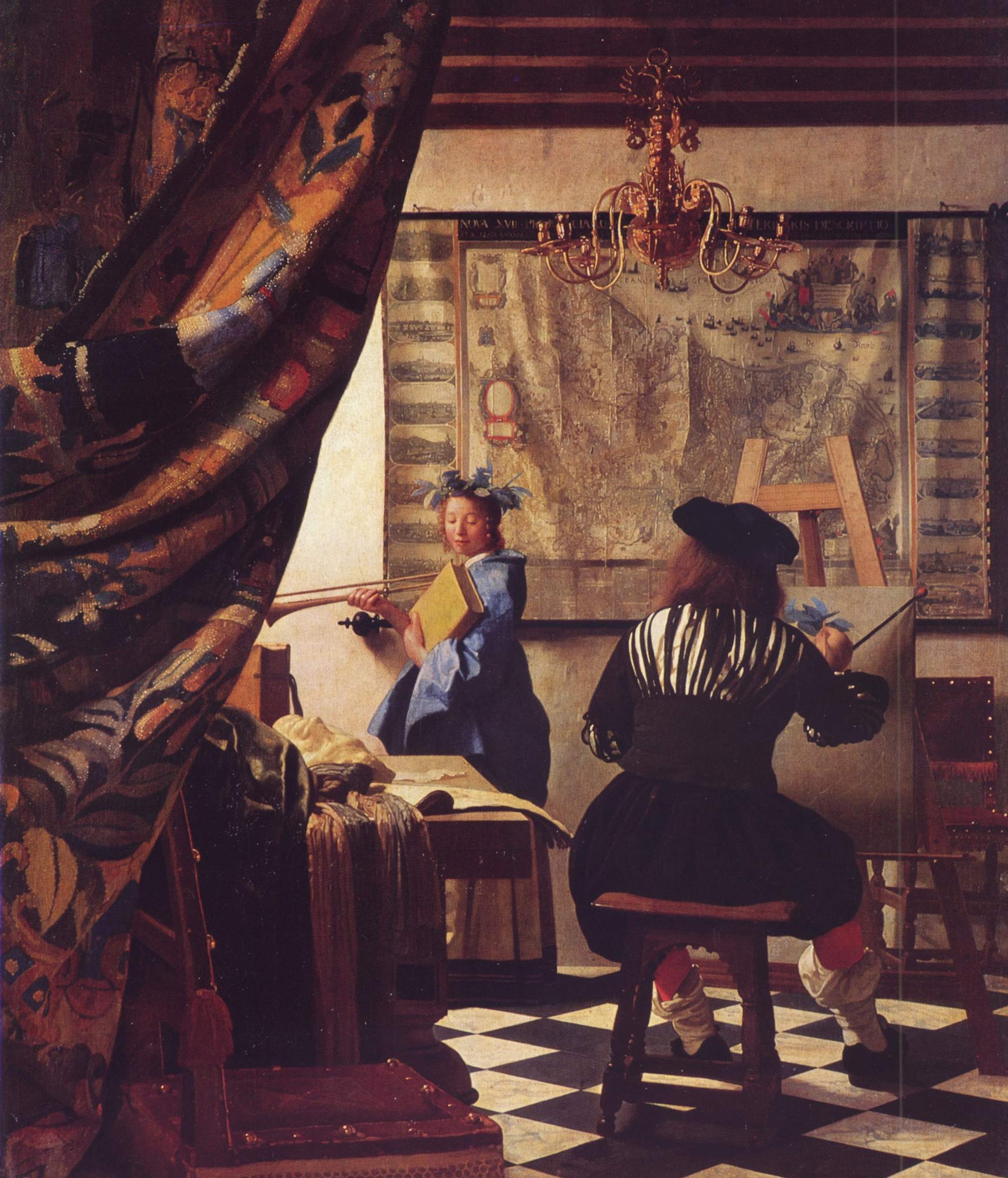- The Art of Painting
Infobox Painting|

title=The Art of Painting
artist=Johannes Vermeer
year=c. 1666
type=Oil on canvas
height=130
width=110
city=Vienna
museum=Kunsthistorisches Museum The Art of Painting, also known as The Allegory of Painting, Die Allegorie der Malerei or Painter in his Studio, is a famous 17th century oil on
canvas painting by Dutch painter,Johannes Vermeer . Many art experts believe that the work of art is anallegory of painting, hence the alternate title of the painting. It is the largest and most complex of all of Vermeer's works.The painting is famous for being one of Vermeer's favourites, and is also a fine example of the optical style of painting. Created in an age without photography, it offers a realistic visual depiction of the scene and is a fine example of the
camera obscura style. The use of bright colours, and the impact of light streaming through the windows on various elements of the painting, are other highlights.Description
The painting depicts an intimate scene of a painter painting a female subject in his studio, by a window, with the background of a large map of the
Netherlands .Elements
The painting has only two characters, the painter and his subject. The painter is thought to be a self-portrait of the artist, though the face is not visible.
A number of the items shown in the artist's studio are thought to be out of place. The marble tiled floor and the golden chandellier are two examples of items which would normally then be reserved for the houses of the well-to-do.
The map in the background is of the Seventeen United Provinces of the Netherlands, flanked by views of the main centres of power, It was published by
Cleas Jansz Visscher in 1636.ymbolism and allegory
Experts attribute symbolism to various aspects of the painting.
The subject is the
Muse ofHistory ,Clio . This is evidenced by her wearing a laurel wreath, holding a horn (depicting fame), and carrying a book (depicting knowledge) according toCesare Ripa 's 16th century book on emblems and personifications titled "Iconologia ".The double headed eagle, symbol of the
Austria nHabsburg dynasty and former rulers of Holland, which adorns the central golden chandellier, may have represented theCatholic faith. Vermeer was unique in being a Catholic in a predominantlyProtestant Holland. The absence of candles in the chandellier is also supposed to represent the suppression of the Catholic faith.The mask lying on the table next to the artist is thought to be a
death mask , depicting the ineffectiveness of the Habsburg monarch.History
The painting is considered an essential Vermeer piece because the painter himself did not part with it or sell it, even when he was in debt. Even after his death in 1676, his widow Catharina bequeathed it to her mother, Maria Thins, in an attempt to avoid the sale of the painting to satisfy creditors. The executor of Vermeer's estate, the famed Delft microscopist
Anton van Leeuwenhoek , determined that the transferral of the work to the late painter's mother-in-law was illegal.The painting lay undiscovered for a century until its purchase for 50 florins in 1813 by the
Austria n count, Johann Rudolf Czernin. Until 1860, the painting masqueraded as one by Vermeer's arch rival and contemporary,Pieter de Hooch . Pieter's signature was even forged on the painting. It was only at the intervention of French Vermeer scholar,Thoré Bürger that it was recognised as a Vermeer original and hence began its fame. It was placed on public display inVienna on behalf of the family until the invasion of Austria by the Nazis in 1939.Nazi interest
After the Nazi invasion of Austria, top Nazi officials including Reichsmarschall
Hermann Goering attempted to acquire the painting. It was finally acquired from its then owner, CountJaromir Czernin byAdolf Hitler for his personal collection at a price of 1.65million Reichsmark through his agent, Hans Posse onNovember 20 ,1940 [ [http://www.nga.gov/exhibitions/verm_6.shtm Vermeer: The Art of Painting, The Painting's Afterlife - NGA ] ] . The painting was rescued from a salt mine at the end ofWorld War II in 1945, where it was preserved fromAllied bombing raids, with other works of art.The Americans returned the painting to the Austrian Government in 1946, since the Czernin family were deemed to have sold it voluntarily, without undue force to Hitler. It is now the property of the State of Austria.
Location
The painting is presently on display at the
Kunsthistorisches Museum inVienna ,Austria , where it has been on display since it was acquired by the Austrian government in 1946.References
Wikimedia Foundation. 2010.
